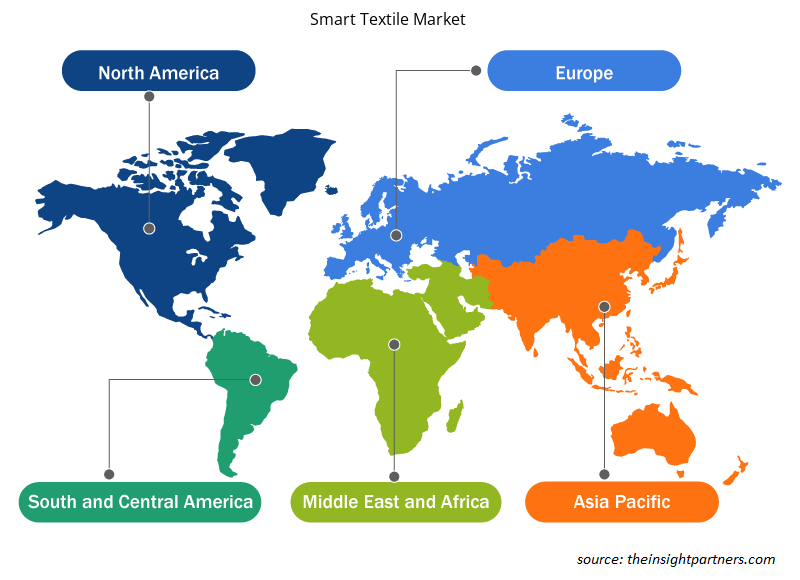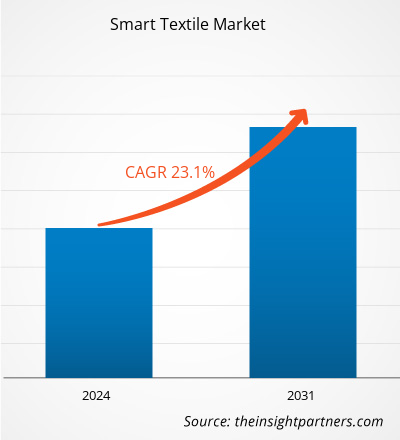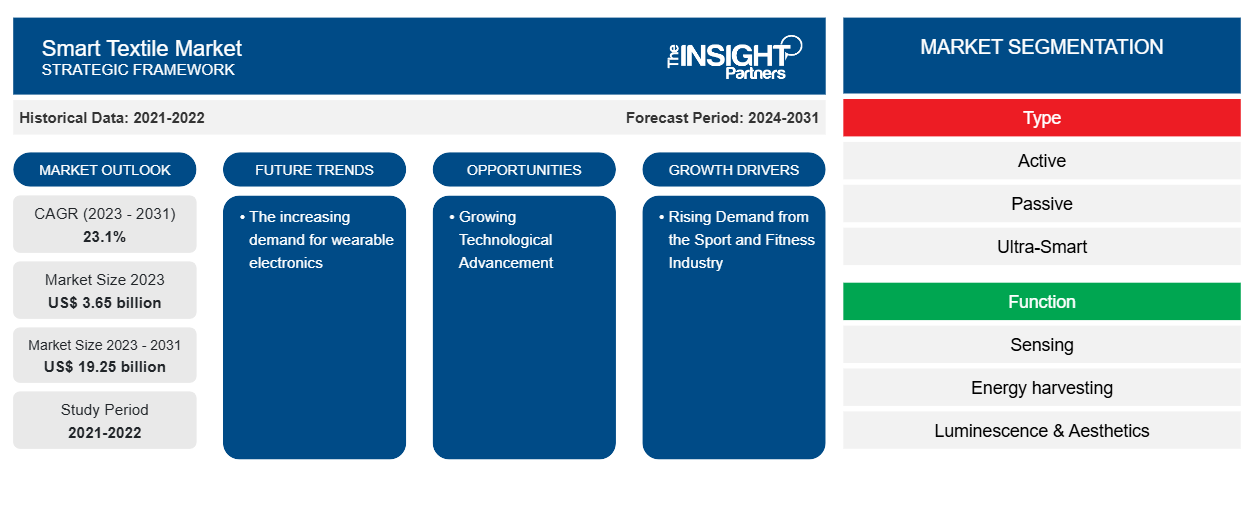Si prevede che la dimensione del mercato dei tessuti intelligenti raggiungerà i 19,25 miliardi di dollari entro il 2031, rispetto ai 3,65 miliardi di dollari del 2023. Si prevede che il mercato registrerà un CAGR del 23,1% nel 2023-2031. È probabile che la crescente domanda di elettronica indossabile rimanga una tendenza chiave del mercato dei tessuti intelligenti.
Analisi del mercato tessile intelligente
Il settore tessile ha assistito a una trasformazione enorme grazie ai progressi nei materiali tessili intelligenti, che hanno consentito alle aziende di espandere la propria portata in applicazioni high-tech e aree al di fuori del loro mercato convenzionale. I tessuti intelligenti sono materiali che sono stati integrati con potenza di calcolo per offrire funzionalità extra come stimolazione, comunicazione e monitoraggio. Il settore dell'elettronica indossabile si sta espandendo a causa della diminuzione delle tendenze di ridimensionamento nell'elettronica moderna e della crescente domanda di gadget intelligenti. Anche lo sviluppo di RFID , tecnologie di sensori e nanotecnologia nei tessuti ha stimolato l'espansione del mercato.
Panoramica del mercato dei tessuti intelligenti
I tessuti intelligenti sono tessuti che sono stati combinati con elementi digitali come fibre conduttive, microcontrollori e sensori. Questi tessuti possiedono la capacità di percepire, rispondere e adattarsi ai cambiamenti nell'ambiente circostante o agli stimoli derivanti da cause chimiche, meccaniche o termiche. I tessuti intelligenti, a differenza dei materiali normali, includono caratteristiche interattive che possono trasferire dati. Sono sempre più utilizzati nei settori sanitario, sportivo, della moda e militare. In ambito sanitario, possono monitorare i segni vitali e avvisare il personale medico. Sono in grado di tracciare i parametri delle prestazioni negli sport. Gli usi militari includono mimetizzazione migliorata e giubbotti antiproiettile con dispositivi di comunicazione integrati.
Personalizza questo report in base alle tue esigenze
Riceverai la personalizzazione gratuita di qualsiasi report, comprese parti di questo report, o analisi a livello nazionale, pacchetto dati Excel, oltre a usufruire di grandi offerte e sconti per start-up e università
- Scopri le principali tendenze di mercato in questo rapporto.Questo campione GRATUITO includerà analisi di dati che spaziano dalle tendenze di mercato alle stime e alle previsioni.
Driver e opportunità del mercato tessile intelligente
Crescente domanda da parte del settore dello sport e del fitness
Gli amanti del fitness e gli atleti sono costantemente alla ricerca di metodi per aumentare i risultati e le prestazioni dell'allenamento. I tessuti intelligenti sono la soluzione perfetta per questo percorso di ottimizzazione. Questi tessuti, che vanno dai calzini che valutano l'andatura alle magliette che tracciano l'attività muscolare, offrono una moltitudine di dati che possono essere utilizzati per modificare i piani di allenamento ed evitare incidenti. Inoltre, i dati raccolti possono essere sincronizzati con smartphone o altri dispositivi, consentendo un'azione immediata in risposta al feedback in tempo reale. Sia gli atleti che i runner occasionali possono ora accedere a questo livello di raccolta di dati a grana fine che in precedenza era esclusivo dei laboratori sportivi specializzati. Inoltre, l'attenzione globale in espansione sulle tendenze della salute e del benessere sta guidando la domanda di tessuti intelligenti nello sport e nel fitness, poiché forniscono un modo semplice per monitorare numerosi dati che possono contribuire a uno stile di vita migliore e più attivo.
Progresso tecnologico in crescita
Il settore tessile è cambiato a seguito dell'introduzione di nuove tecnologie come l'intelligenza artificiale (AI) e l'Internet of Things (IoT). AI, Bluetooth Low Energy (BLE), edge computing e dati cloud vengono tutti combinati in nuovi indumenti intelligenti che vengono prodotti. Questi indumenti possono monitorare e trasmettere i dati di chi li indossa, come temperatura, frequenza cardiaca, pressione sanguigna e sudorazione. AI ha la capacità di recuperare e raccogliere dati operativi sia nel passato che nel presente, oltre a offrire informazioni che possono migliorare la produttività di chi li indossa. AI è frequentemente utilizzato nella produzione tessile per una varietà di scopi, tra cui la corrispondenza dei colori, l'ispezione dei modelli e il rilevamento dei difetti. Inoltre, l'integrazione di AI ha reso possibile la produzione di indumenti intelligenti che utilizzano sensori elettrici e IoT per fornire un'esperienza utente eccezionale. Pertanto, l'incorporazione di tecnologie nei tessuti può creare un'esperienza più confortevole e orientata alla salute, che dovrebbe creare un'opportunità per la crescita del mercato dei tessuti intelligenti nel periodo previsto.
Analisi della segmentazione del rapporto di mercato sui tessuti intelligenti
I segmenti chiave che hanno contribuito alla derivazione dell'analisi del mercato dei tessuti intelligenti sono tipologia, funzione e settore verticale.
- In base al tipo, il mercato dei tessuti intelligenti è segmentato in attivo, passivo e ultra-intelligente. Si prevede che il segmento attivo crescerà nel periodo previsto.
- In base alla funzione, il mercato è segmentato in rilevamento, raccolta di energia, luminescenza ed estetica e termoelettricità. Si prevede che il segmento del rilevamento crescerà nel periodo previsto.
- Per settore verticale, il mercato è segmentato in sanità, sport e fitness, moda, militare e automotive. Si prevede che il segmento sport e fitness crescerà nel periodo previsto.
Analisi della quota di mercato dei tessuti intelligenti per area geografica
L'ambito geografico del rapporto sul mercato dei tessuti intelligenti è suddiviso principalmente in cinque regioni: Nord America, Asia Pacifico, Europa, Medio Oriente e Africa e Sud America/Sud e Centro America.
In termini di fatturato, il Nord America ha rappresentato la quota di mercato più grande del tessile intelligente. Il mercato in questa regione è segmentato in Stati Uniti, Canada e Messico. L'espansione del mercato regionale è guidata dai crescenti investimenti governativi nei settori della difesa e militare, nonché dal forte potere d'acquisto. Inoltre, una larga parte della popolazione nella regione soffre di obesità, rendendola una delle principali sfide per la salute. Di conseguenza, i consumatori stanno gravitando verso uno stile di vita sano e acquistando beni che supporteranno la loro continua attività fisica. Di conseguenza, per rimanere competitivi, gli operatori del mercato stanno concentrando i loro sforzi sulla fornitura di articoli all'avanguardia a costi accessibili. Inoltre, la crescente spesa governativa per iniziative di ricerca e sviluppo, in particolare nel settore sanitario, sta alimentando ulteriormente la crescita del mercato del tessile intelligente.
Approfondimenti regionali sul mercato tessile intelligente
Le tendenze regionali e i fattori che influenzano lo Smart Textile Market durante il periodo di previsione sono stati ampiamente spiegati dagli analisti di Insight Partners. Questa sezione discute anche i segmenti e la geografia dello Smart Textile Market in Nord America, Europa, Asia Pacifico, Medio Oriente e Africa e Sud e Centro America.

- Ottieni i dati specifici regionali per il mercato tessile intelligente
Ambito del rapporto sul mercato tessile intelligente
| Attributo del report | Dettagli |
|---|---|
| Dimensioni del mercato nel 2023 | 3,65 miliardi di dollari USA |
| Dimensioni del mercato entro il 2031 | 19,25 miliardi di dollari USA |
| CAGR globale (2023-2031) | 23,1% |
| Dati storici | 2021-2022 |
| Periodo di previsione | 2024-2031 |
| Segmenti coperti | Per tipo
|
| Regioni e Paesi coperti | America del Nord
|
| Leader di mercato e profili aziendali chiave |
|
Densità degli attori del mercato: comprendere il suo impatto sulle dinamiche aziendali
Il mercato Smart Textile Market sta crescendo rapidamente, spinto dalla crescente domanda degli utenti finali dovuta a fattori quali l'evoluzione delle preferenze dei consumatori, i progressi tecnologici e una maggiore consapevolezza dei vantaggi del prodotto. Con l'aumento della domanda, le aziende stanno ampliando le loro offerte, innovando per soddisfare le esigenze dei consumatori e capitalizzando sulle tendenze emergenti, il che alimenta ulteriormente la crescita del mercato.
La densità degli operatori di mercato si riferisce alla distribuzione di aziende o società che operano in un particolare mercato o settore. Indica quanti concorrenti (operatori di mercato) sono presenti in un dato spazio di mercato in relazione alle sue dimensioni o al valore di mercato totale.
Le principali aziende che operano nel mercato dei tessuti intelligenti sono:
- Dupont
- Giabil
- Sensori
- Abbigliamento interattivo AG
- Adidas
- Esopelle
Disclaimer : le aziende elencate sopra non sono classificate secondo un ordine particolare.

- Ottieni una panoramica dei principali attori del mercato tessile intelligente
Notizie e sviluppi recenti del mercato tessile intelligente
Il mercato dei tessuti intelligenti viene valutato raccogliendo dati qualitativi e quantitativi dopo la ricerca primaria e secondaria, che include importanti pubblicazioni aziendali, dati associativi e database. Di seguito è riportato un elenco degli sviluppi nel mercato:
- Loomia Technologies ha collaborato con Advanced Functional Fabrics of America (AFFOA) per sviluppare guanti riscaldati altamente tattili che potrebbero essere applicabili sia ai clienti commerciali/ricreativi che militari. Per questo progetto collaborativo, Loomia fornirà la tecnologia da utilizzare in un inserto per guanti riscaldati, mentre AFFOA guiderà la scoperta dei clienti, fornirà progetti di architettura di sistema e produrrà un'unità di controllo dell'interfaccia. Oltre all'inserto per guanti riscaldati, Loomia svilupperà anche una manica riscaldata. Entrambi gli articoli forniranno comfort termico agli utenti in climi rigidi o in altre aree in cui questa protezione è ritenuta necessaria. (Fonte: Loomia Technologies, comunicato stampa, 2022)
- La UK Fashion and Textile Association (UKFT) ha annunciato una partnership con Smart Textile Alliance. La partnership tra STA e UKFT sarà reciprocamente vantaggiosa, aprendo il potenziale per nuove vie di innovazione nella tecnologia e nella moda. (Fonte: UKFT, comunicato stampa, 2021)
Copertura e risultati del rapporto sul mercato tessile intelligente
Il rapporto “Dimensioni e previsioni del mercato tessile intelligente (2021-2031)” fornisce un’analisi dettagliata del mercato che copre le seguenti aree:
- Dimensioni e previsioni del mercato a livello globale, regionale e nazionale per tutti i segmenti di mercato chiave coperti dall'ambito
- Dinamiche di mercato come fattori trainanti, vincoli e opportunità chiave
- Principali tendenze future
- Analisi dettagliata delle cinque forze PEST/Porter e SWOT
- Analisi di mercato globale e regionale che copre le principali tendenze di mercato, i principali attori, le normative e gli sviluppi recenti del mercato
- Analisi del panorama industriale e della concorrenza che copre la concentrazione del mercato, l'analisi della mappa di calore, i principali attori e gli sviluppi recenti
- Profili aziendali dettagliati
- Analisi storica (2 anni), anno base, previsione (7 anni) con CAGR
- Analisi PEST e SWOT
- Valore/volume delle dimensioni del mercato - Globale, Regionale, Nazionale
- Industria e panorama competitivo
- Set di dati Excel
Report recenti
Testimonianze
Motivo dell'acquisto
- Processo decisionale informato
- Comprensione delle dinamiche di mercato
- Analisi competitiva
- Analisi dei clienti
- Previsioni di mercato
- Mitigazione del rischio
- Pianificazione strategica
- Giustificazione degli investimenti
- Identificazione dei mercati emergenti
- Miglioramento delle strategie di marketing
- Aumento dell'efficienza operativa
- Allineamento alle tendenze normative





















 Ottieni un campione gratuito per - Mercato tessile intelligente
Ottieni un campione gratuito per - Mercato tessile intelligente